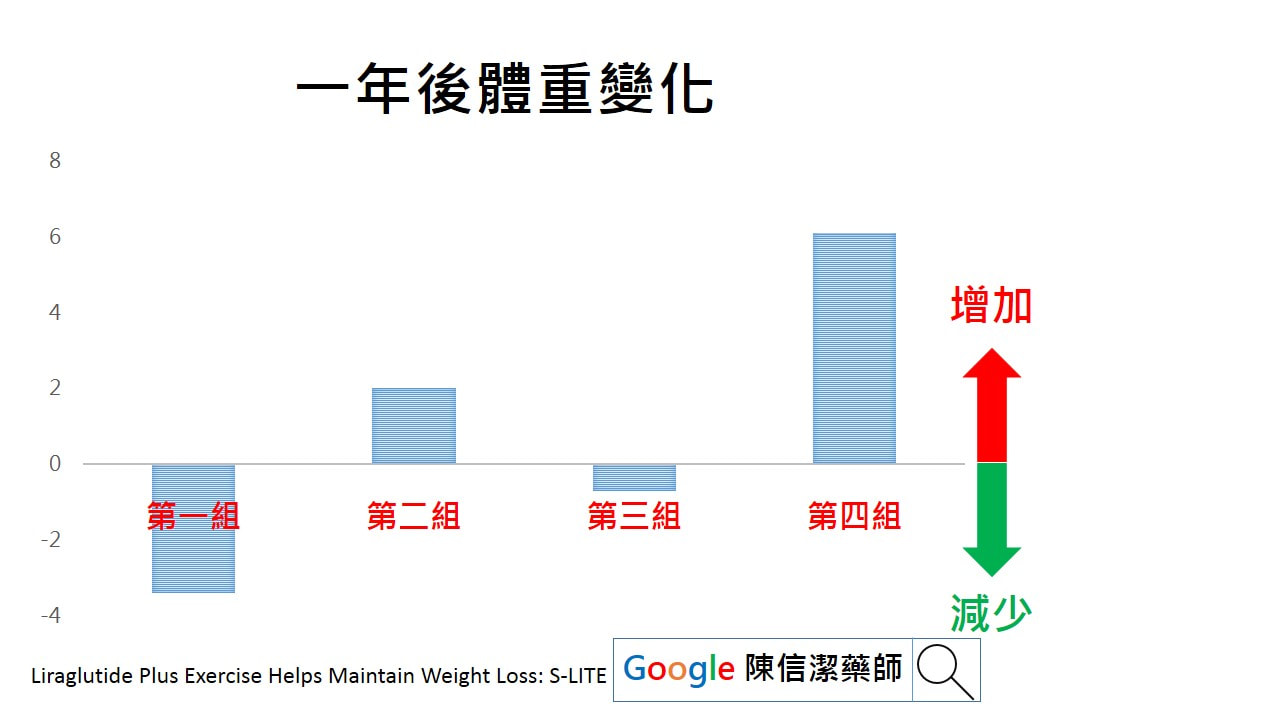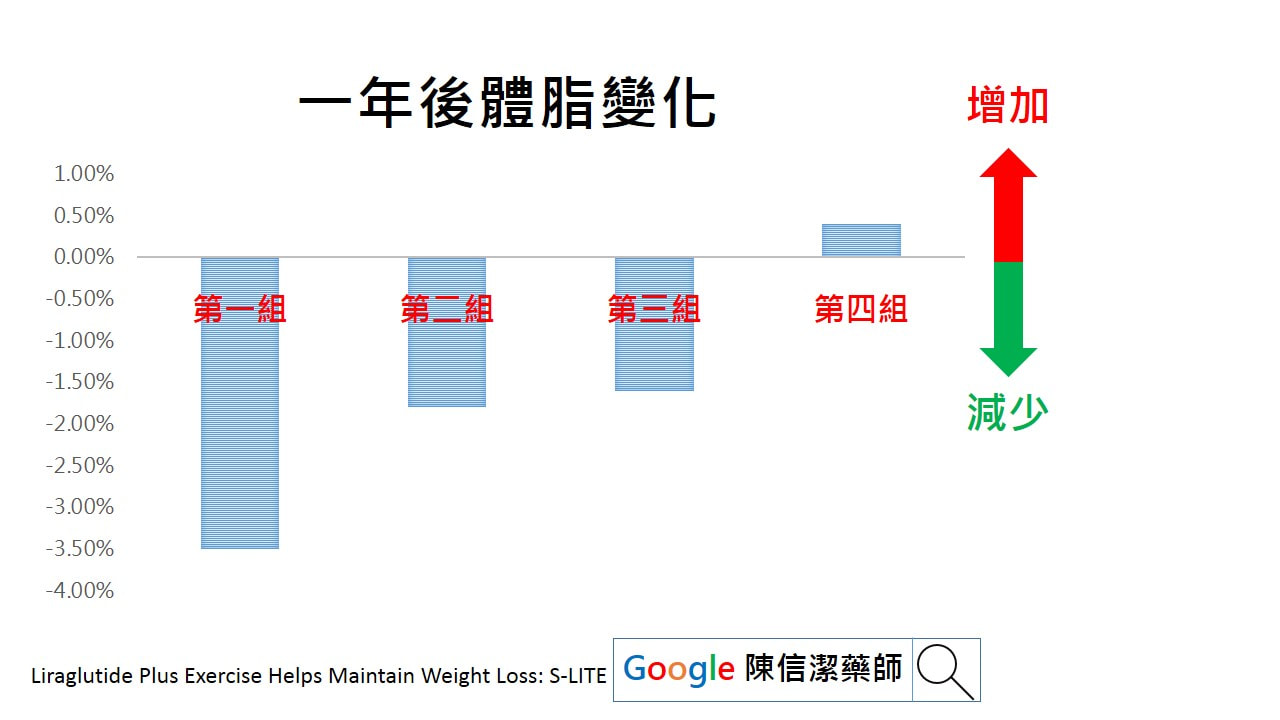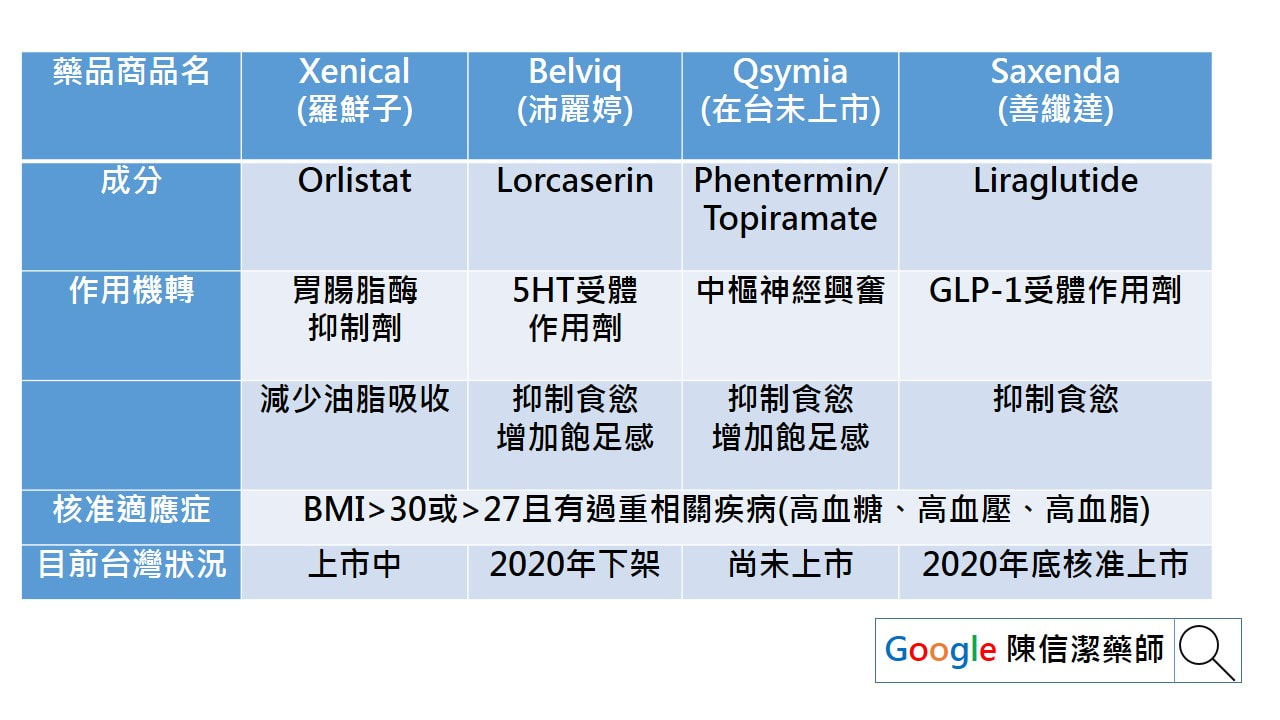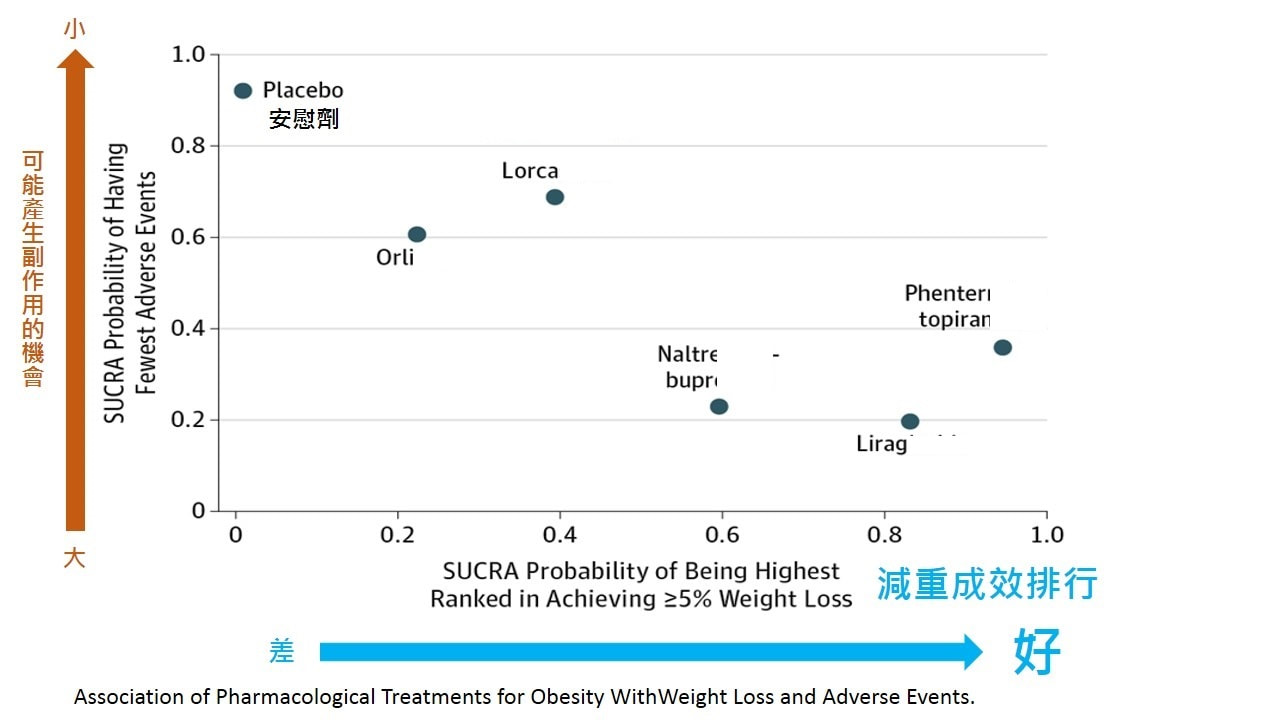|
在過去的研究指出,針對過重肥胖但沒有糖尿病的患者,善纖達SAXENDA具有減重的效果。而且在美國(2014年核准上市),歐盟,韓國(2018年核准上市)等地獲得減重的適應症。2020年美國糖尿病學年會發表的研究發現,善纖達SAXENDA搭配運動同時進行,對於減重人士來說,減重後的一年更能有效維持體重,避免復胖的窘境發生。 研究設計 這項以S-LITE(Combined Effects of GLP-1 Analogue and Exercise on Maintenance of Weight Loss and Health After Very-low Calorie Diet)的研究,找了200名在18到65歲之間,BMI介於32到43 (kg/m^2),且沒有糖尿病,未進行胃繞道手術,且以前每週運動不到2小時的減肥人士。 在研究開始,先給參與試驗者每日800大卡的非常低熱量飲食,且長達8週的時間,其中195位患者(91%)達到減少5%以上體重。這195位患者平分成四組,分成 第一組: 每天施打3.0mg 善纖達SAXENDA(Liraglutide)搭配每週運動150分鐘 第二組: 施打安慰劑,但每週運動150分鐘 第三組: 每天施打3.0mg善纖達SAXENDA(Liraglutide)不搭配運動指導 第四組: 施打安慰劑,但不運動。 運動組包含每週有教練監督的運動兩次以及每週兩次的個人運動,達到每週150分鐘。而兩次監督的運動,包含30分鐘的高強度間歇性運動(HIIT)以及15分鐘的循環訓練(Circuit Training)。觀察一年後的體重變化。 來看看這些參與者平均年齡42歲,體重107.6公斤,BMI(身體質量指數)36.5kg/m^2, 36%的男性以及64%女性。 研究結果 在起始八週時,所有參與者平均減少13.1公斤的體重。 在一年後,來比較體重的變化 第一組:施打善纖達SAXENDA搭配運動組則額外減少了3.4公斤。 第二組:單獨運動組,復胖2.0公斤 第三組:單獨使用善纖達SAXENDA又再減少0.7公斤 第四組什麼都沒做的復胖6.1公斤 在起始八週時,所有參與者平均減少了2.3%的體脂肪。 一年後,來比較體脂的變化, 第一組:施打善纖達SAXENDA搭配運動者,減少了3.5%體脂肪。善纖達SAXENDA搭配運動組,在減少脂肪同時,也仍然保留了肌肉重量(lean muscle mass)。 第二組:單獨運動者減少1.8%體脂肪 第三組:單獨使用Liraglutide者減少1.6%體脂肪 第四組:什麼都沒做的復胖0.4%體脂 討論 減重最困難的並不是在一次能減少多少體重,而是在減重後的半年到一年開始復胖,而復胖後的體重,可能比減重前更重,體脂比減重前更高,而造成溜溜球效應。所以,如何維持減重者不復胖,也是減重者相當關心的事。 過去的研究也指出,以平均值來說,單純生活習慣的介入,在一年後的復胖比例較高,減重效果較差,而持續的藥物介入者,較能維持較久的時間不復胖。胃繞道手術則能維持非常長的時間不復胖。 這則研究簡單說的說就是指出,使用藥物善纖達SAXENDA搭配運動,不僅可以不復胖,還能減少更多的體重與體脂。 不管如何減重還是建議搭配運動,才能讓身體更好更健康! 結論 針對肥胖患者,在使用非常低熱量飲食做初期減重後,合併使用Liraglutide加上運動進行一年時間,可以有效維持體重,甚至減少更多體脂肪而不復胖。 參考資料 Liraglutide Plus Exercise Helps Maintain Weight Loss: S-LITE 底下是原文:
A year of regular exercise plus daily subcutaneous injections of the glucagon-like peptide-1 (GLP-1) receptor agonist liraglutide (Saxenda, Novo Nordisk) was superior to placebo or liraglutide or exercise alone in maintaining weight loss, in a new study. The S-LITE trial randomized close to 200 healthy patients with obesity but no diabetes who had lost at least 5% of their initial weight on an 8-week very low-calorie diet to one of these four treatment regimens for weight-loss maintenance. With the combined treatment, the patients not only kept the most weight off, they also lost the most body fat while preserving muscle mass. "Therefore, we recommend this combined use of exercise and liraglutide after weight loss," Julie R. Lundgren, MD, and a PhD student, concluded in her oral presentation of the trial results during the virtual American Diabetes Association (ADA) 80th Scientific Sessions. The study shows "how important it is to initiate a strategy for weight [loss] maintenance," Lundgren and senior author Signe S. Torekov, PhD, both from the University of Copenhagen, Denmark, told Medscape Medical News in an email. "It is not enough to go on a diet and lose weight," they stressed. Patients need "some kind of active treatment after the weight loss in order to maintain [this lower] weight and health benefits" that go along with it. This combined treatment would most likely also help patients with type 2 diabetes maintain weight loss, they speculated. Although, they added, "depending on how long you have had type 2 diabetes, it may be more difficult to reverse adverse effects of type 2 diabetes." Therefore, it is better to lose weight before developing diabetes (for which obesity is a risk factor). What Is the Best Way to Prevent Weight Regain? S-LITE was a randomized placebo-controlled trial designed to investigate 1-year weight-loss maintenance and change in body fat and muscle mass using four strategies in healthy patients with obesity. The trial enrolled 215 participants who were 18-65 years old with a body mass index (BMI) of 32-43 kg/m2 and no diabetes or previous bariatric surgery, who did less than 2 hours of vigorous exercise a week. On average, the participants were 42 years old, weighed 107.6 kg (237 lb), and had a BMI of 36.5 kg/m2; 64% were women. After an 8-week very low-calorie diet (800 kcal/day), 195 patients (91%) had lost the required ≥ 5% of body weight and were able to enter the maintenance phase. They were randomized to 1 year of treatment with liraglutide 3.0 mg/day; exercise 150 minutes/week (plus placebo); exercise 150 minutes/week plus liraglutide 3.0 mg/day (combination); or placebo. Participants injected themselves with either placebo or liraglutide daily (depending on what group they were in). The exercise intervention consisted of two supervised sessions per week and two individual sessions per week, to reach 150 minutes/week of activity. The supervised exercise sessions, which took place in the department of physiology, Hvidovre Hospital, consisted of 30 minutes of high-intensity interval-based cycling and 15 minutes of circuit training, guided by exercise trainers affiliated with the study. The drop-out rate was low. At 1 year, 41 of 49 randomized patients in the liraglutide group, 40 of 48 patients in the exercise group, 45 of 49 patients in the combination group, and 40 of 49 patients in the placebo group completed the study. Greatest Success With Combined Strategy At the start of the weight-loss maintenance phase, participants had lost an average of 13.1 kg. At 1 year, patients in the liraglutide only group had lost an additional 0.7 kg; patients in the exercise group had regained 2.0 kg; and participants in the placebo group had regained about half of what they had lost (6.1 kg). However, participants in the combined exercise and liraglutide group had lost an additional 3.4 kg. Moreover, participants in the liraglutide and exercise group lost fat while preserving lean muscle mass. At the start of the weight-loss maintenance phase, participants had lost an average of 2.3% of their body fat. After 1 year, participants in the combined liraglutide and exercise group had lost an additional 3.5% of their body fat — which was greater than the loss of body fat in the exercise group (1.8%) and liraglutide group (1.6%), or the gain of body fat in the placebo group (0.4%). "The compliance to both study medication and the exercise program was very high in our study," Torekov and Lundgren said, "so we consider the combined treatment strategy as feasible with the correct guidance and supervision." However, they stressed that guided exercise is especially important when initiating a program for untrained individuals, and studies have shown that it may be more difficult to adhere to long-term unsupervised exercise programs. And the cost of liraglutide may be a potential drawback for some individuals, they acknowledged. Likewise, exercising at a gym may be costly, "but it is also possible to exercise outside the gym on your own for free, for example by cycling, brisk walking, or running." Moreover, "later treatment of the comorbidities associated with obesity (type 2 diabetes, cardiovascular disease, etc) is also costly," they point out. "In general, the participants liked the treatment programs as is also reflected in the low dropout rate and high adherence to the programs," the researchers concluded. Torekov has reported receiving research support from Novo Nordisk. Lundgren has reported no relevant financial relationships. Disclosures for the other authors are listed in the abstract. ADA 2020 Scientific Sessions. Presented June 13, 2020. Abstract 139-OR.
0 評論
根據2016年刊登在JAMA上的系統性綜論 (systematic review),研究學者以網絡統合分析 (network meta-analysis) 的方式分析比較了目前美國FDA核准用於減重的藥品療效,這些藥物分別是Belviq(沛麗婷)、Qsymia(在台未上市)、Saxenda(善纖達)及Xenical(羅鮮子)。 以下是比較的各個藥物比對介紹: 這個分析總共有27項隨機分派研究,有26項是與安慰劑比較,只有一項是兩個互比 (Xenical與Saxenda),分析結果顯示,減重超過5%排序第一名是Qsymia,其次是Saxenda(善纖達)。 也就是目前台灣核准的減重藥中,以機率來看成功減重超過5%的第一名是善纖達SAXENDA減重針(減肥針)。 當然不能只著重減重成效,卻忽略副作用。
在抑制慾望的減重藥品中,如Belviq(沛麗婷)或 Qsymia,大多中樞神經興奮的關係,大多有心跳加快、頭痛的問題。而透過調控胰島素的Saxenda(善纖達),則是腸胃不適(噁心、嘔吐等)。 而排油系的Xenical(羅鮮子)大多有噴油、來不及到廁所等都是油便的問題。 但是,如果對個人來說,可能因個人體質等等因素,還是會有些差異。 最後一提,成功減重機率大,當然相對的發生副作用的機率,也可能比較高。 因此,還是要注意自己在使用中是否有副作用的情況發生,所以也建議隨時聯繫您的家庭醫師或家庭藥師。 (仿單上的副作用,是大量人體試驗累積下來的數據,並不是所有的副作用都會發生,也不是所有的人都會經歷副作用的過程。) 若有任何問題,也歡迎加入新德大藥局官方LINE詢問。 |
依主管機關相關規定,專業醫藥資訊僅提供醫藥專業人員參考(請申請核可通過後,即可閱讀專業人員區)。
恕不對外開放非專業人士使用。 每月文章
一月 2023
類別 |
營業時間:週一至週日(全年無休) 早上九點至晚上十一點四十分 (09:00~23:40)
|
地址:台北市松山區饒河街204號
|
聯絡我們 |





 RSS 訂閱
RSS 訂閱
